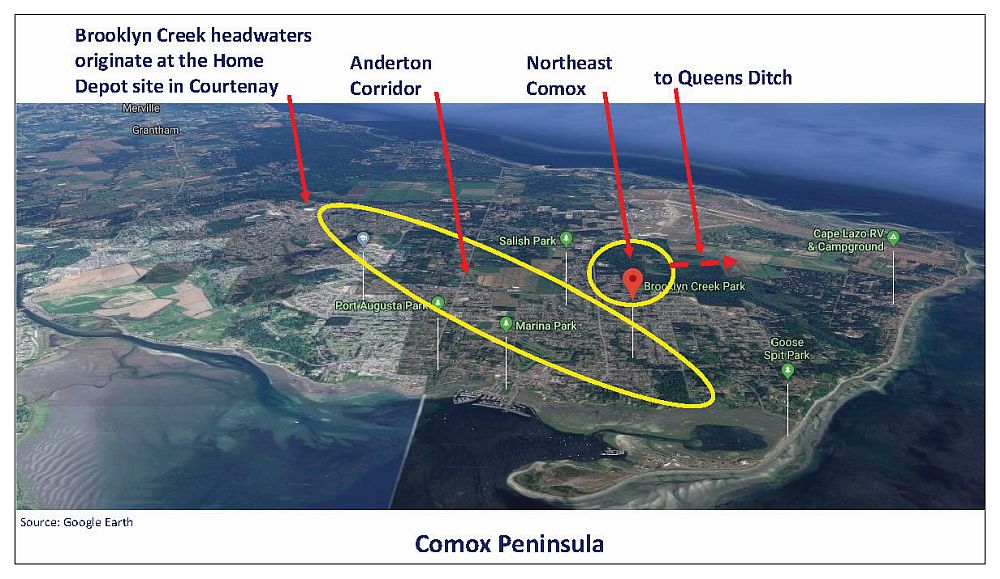APPROACH TO LAND DEVELOPMENT IN NORTHEAST COMOX IS PRECEDENT-SETTING: “As we proceed with next steps, the most challenging will be educating staff, developers, consultants, and home owners of the new standards, procedures, policies and guidelines,” stated Shelley Ashfield, Municipal Engineer, Town of Comox
Note to Reader:
In September 2019, the Partnership for Water Sustainability in British Columbia released the 8th in the Watershed Case Profile Series. It features the Town of Comox, and the Brooklyn Creek Watershed Society, in the Comox Valley region of Vancouver Island.
The Watershed Case Profile Series is unique. The series showcases and celebrates successes and long-term ‘good work’ in the local government setting in British Columbia. The Partnership’s spotlight is on champions in communities which are breaking new ground and establishing replicable precedents.
DOWNLOAD: Comox-Beacon of Hope_Sep2019

A Beacon of Hope
 “British Columbia is at a tipping point. Will local governments bridge the gap between policy and new standards of practice, reconnect hydrology and ecology, create greener communities, and adapt to climate change?,” wrote Kim Stephens, Partnership Executive Director, in the preface to Town of Comox – A ‘Beacon of Hope’ for Citizen Science in Action & Reconnecting Hydrology and Ecology through the Water Balance Approach to Land Development.
“British Columbia is at a tipping point. Will local governments bridge the gap between policy and new standards of practice, reconnect hydrology and ecology, create greener communities, and adapt to climate change?,” wrote Kim Stephens, Partnership Executive Director, in the preface to Town of Comox – A ‘Beacon of Hope’ for Citizen Science in Action & Reconnecting Hydrology and Ecology through the Water Balance Approach to Land Development.
“The Partnership for Water Sustainability has identified Comox as a beacon of hope because the Town’s experience shows what is possible when a local government has a strong working relationship with the stewardship sector, and leads by example to implement responsible water balance management.”
A Building Blocks Approach
“The Town’s journey comprises three building blocks. Over the past decade, experience gained and lessons learned through the Lower Brooklyn Creek channel enhancement project and Northeast Comox land development planning process have been integrated into the Draft Anderton Corridor Neighbourhood Concept Plan for Middle Brooklyn Creek.
“The Draft Anderton Corridor Concept Plan is precedent-setting because it demonstrates how application of the Ecological Accounting Process (EAP) approach helps managers change practices and adopt new strategies regarding the protection and enhancement of ecological systems in the stream corridor and riparian zone, and throughout the entire creekshed.
“The Town is reconnecting hydrology and ecology by embarking on a systems approach on all levels. The approach includes amending bylaws, training staff, educating the development community and homeowners, creating new procedures, and formalizing roles and responsibilities.
“By taking action to reconnect hydrology and ecology, Comox is moving along a pathway that ultimately leads to a water-resilient future where flood and drought risks would be reduced, and ecological services would be sustained.

Northeast Comox Land Development
“The Town of Comox has established a provincial precedent in truly applying a whole-system, water balance approach to land development in Northeast Comox. The break from historical drainage engineering practice dates back to April 2012 when Council approved Terms of Reference for a North East Comox Storm Water Management Plan,” reported Kim Stephens.
“Over the past seven years, an approach has taken shape that follows the direction provided by Stormwater Planning: A Guidebook for British Columbia, released by the provincial government in 2002. The Guidebook introduced the Water Balance Methodology as a way to set performance targets for reducing runoff volume and mimicking the natural flow patterns in streams, and so protect property and habitat.” Kim Stephens was project manager and principal author of the Guidebook.
A Protracted Process
 “The Town had the reality of a legal issue related to flooding in the lowlands where the Queens Ditch is located. The risk management implications necessitated action by the Town,” explains Marvin Kamenz, the Town’s Planner. “The Town has been proactive in requiring use of practices that will fully meet the intent of the water balance approach.
“The Town had the reality of a legal issue related to flooding in the lowlands where the Queens Ditch is located. The risk management implications necessitated action by the Town,” explains Marvin Kamenz, the Town’s Planner. “The Town has been proactive in requiring use of practices that will fully meet the intent of the water balance approach.
“The development approval process for NE Comox could have been done in 1 or 2 years. Instead, it has been an 8-year journey. The Town’s experience shows how hard it is to move a profession and an industry in a new direction.”

The End of the Beginning
“The past 8 years have been hard work. Along the way, the Town followed an incremental process that allowed us to overcome challenges and hurdles,” reports Marvin Kamenz.
“Yet, when all is said and done, we have only just begun. Next up is implementation, with the next piece of the puzzle being financing of the infrastructure and cost recovery so that development can proceed. Aspects to be reconciled are the land and construction costs for detention ponds, plus the operation and maintenance costs.”
 “As we proceed with next steps, the most challenging will be educating staff, developers, consultants, and home owners of the new standards, procedures, policies and guidelines,” adds Shelley Ashfield, the Town’s Municipal Engineer. “Changing engineering standards is a journey in itself. To ensure success, the Town will need to adopt the design standards, update existing subdivision servicing specifications, establish a number of bylaws, and implement a cost recovery program.”
“As we proceed with next steps, the most challenging will be educating staff, developers, consultants, and home owners of the new standards, procedures, policies and guidelines,” adds Shelley Ashfield, the Town’s Municipal Engineer. “Changing engineering standards is a journey in itself. To ensure success, the Town will need to adopt the design standards, update existing subdivision servicing specifications, establish a number of bylaws, and implement a cost recovery program.”

To Learn More:
Download a copy of Town of Comox – A ‘Beacon of Hope’ for Citizen Science in Action & Reconnecting Hydrology and Ecology through the Water Balance Approach to Land Development.
For the story of the presentation by Kim Stephens to Comox Town Council, read URBAN DESIGN & THE PACKAGE OF ECOLOGICAL SERVICES: “The ‘Comox story’ is indeed a blueprint for what the phrase hard work of hope means in practice,” stated Kim Stephens, Partnership for Water Sustainability, when he met with Comox Town Council to present the 8th in the Watershed Case Profile Series (September 2019)
The ‘table of contents’ presented below is a synopsis of the ‘Comox story’. It distills the essence of each section into a succinct statement. These create a storyline. When reading this synopsis, readers should pause and reflect on the messages before continuing.
![]()

